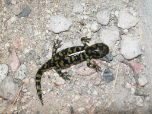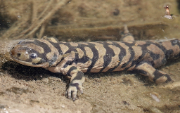Western Tiger Salamander (Ambystoma mavortium)
Description: Western tiger salamanders are one of the largest salamander species, and are the largest terrestrial salamanders in North America. They grow to an average of 20.3 cm, but have been reported to grow up to about 35.6 cm and weigh an average of 126 g. Although both sexes have similar body lengths, male tails are about equal to body size; females have tails a few centimeters shorter than their body. Barred tiger salamanders have four toes that are not webbed in the front and five toes that are not webbed on their back feet. Their heads are flat and broad, with blunt noses, small eyes. They have long, thick tails. Because they are born in water, hatchlings have tail fins and gills. Juveniles at ages of one to three years develop lungs to breathe air and are able to walk on land. However, they still have a tail fin.
Adults and juveniles have a light-grey to grayish-black dorsum with scattered black or yellow dots. They also have yellow bars and lines along their body. Their colors and patterns serve as camouflage in their geographic area, so they blend in with their local habitat. There are no color differences between males and females.
Hatchlings are 13 to 17 mm long and dark yellow-green, with dark brown spots and black lateral stripes. As larvae they are 180 to 250 m long are dark yellow-green with light brown spots and black lateral stripes.
Habitat: Western tiger salamanders inhabit a diversity of ecosystems. They have been found in bottomland deciduous forests, coniferous forests, and woodlands. They are also be found in open fields, bushy areas, alpine and subalpine meadows. They commonly use ponds as breeding grounds and sometimes streams - but only if they are slow moving. Fast streams make it harder for larvae to obtain food, thus reducing survival rates. Although barred tiger salamanders are terrestrial as adults, they live near water sources to breed and to remain cool and moist. When hibernating, they live in cool, moist burrows. These burrows can be new or pre-existing, created by salamanders or other animals. Burrow depths range from 15 to 60 cm.
Range: The barred tiger salamander lives in western Canada and the western half of the United States, but infrequently in California and Nevada. In Canada, it can be found in British Columbia, Alberta, Saskatchewan and Manitoba. Its range in the United States extends to the southernmost tip of Texas, but no further east than the Dakotas and Oklahoma.
Diet: The main diet of Western tiger salamanders consists of beetles, earthworms, and crickets. They have also been reported to eat other amphibians, such as frogs. These salamanders may develop into cannibalistic larval morphs that will eat other larvae and, eventually, other salamanders. Terrestrial adult barred tiger salamanders can eat mice and minnows.
Reproduction: Nothing is published on the reproductive mating systems of this species. However, as a former subspecies of tiger salamanders (Ambystoma tingrinum), it is likely that Ambystoma mavoritum has similar reproductive behaviors. Breeding takes place during most months of the year. The eggs are laid in water and the developing larvae are exclusively aquatic.
Status: Listed as Least Concern in view of the large extent of occurrence, large number of subpopulations and localities, large population size and use of a wide range of habitats.
»» Kingdom: Animalia - Animals
»» Phylum: Chordata - Chordates
»» Subphylum: Vertebrata - Vertebrates
»» Class: Amphibia - (Amphibians)
»» Order: Caudata - Salamanders
»» Family: Salamandridae - Newts
»» Subfamily: Pleurodelinae - Pleurodeline Newts
»» Genus: Ambystoma
»» Species: Ambystoma mavortium - Western Tiger Salamander
This article uses material from the Wikipedia article "Barred Tiger Salamander", which is released under the Creative Commons Attribution-Share-Alike License 3.0. Content may have been omitted from the original, but no content has been changed or extended.
|








